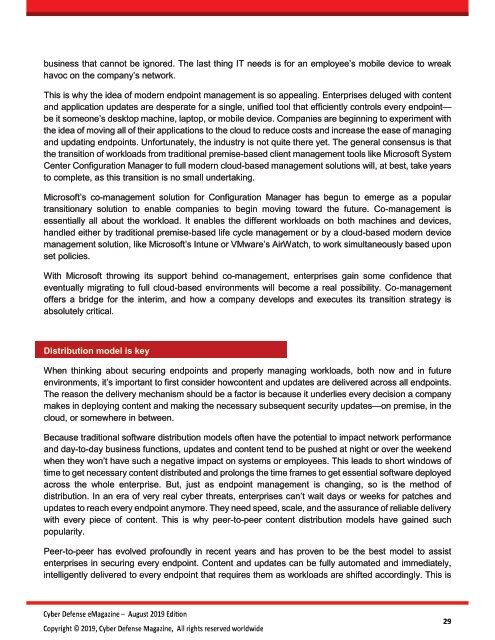Cyber Defense eMagazine August 2019
Cyber Defense eMagazine August Edition for 2019 #CDM #CYBERDEFENSEMAG @CyberDefenseMag by @Miliefsky a world-renowned cybersecurity expert and the Publisher of Cyber Defense Magazine as part of the Cyber Defense Media Group
Cyber Defense eMagazine August Edition for 2019 #CDM #CYBERDEFENSEMAG @CyberDefenseMag by @Miliefsky a world-renowned cybersecurity expert and the Publisher of Cyber Defense Magazine as part of the Cyber Defense Media Group
Create successful ePaper yourself
Turn your PDF publications into a flip-book with our unique Google optimized e-Paper software.
usiness that cannot be ignored. The last thing IT needs is for an employee’s mobile device to wreak<br />
havoc on the company’s network.<br />
This is why the idea of modern endpoint management is so appealing. Enterprises deluged with content<br />
and application updates are desperate for a single, unified tool that efficiently controls every endpoint—<br />
be it someone’s desktop machine, laptop, or mobile device. Companies are beginning to experiment with<br />
the idea of moving all of their applications to the cloud to reduce costs and increase the ease of managing<br />
and updating endpoints. Unfortunately, the industry is not quite there yet. The general consensus is that<br />
the transition of workloads from traditional premise-based client management tools like Microsoft System<br />
Center Configuration Manager to full modern cloud-based management solutions will, at best, take years<br />
to complete, as this transition is no small undertaking.<br />
Microsoft’s co-management solution for Configuration Manager has begun to emerge as a popular<br />
transitionary solution to enable companies to begin moving toward the future. Co-management is<br />
essentially all about the workload. It enables the different workloads on both machines and devices,<br />
handled either by traditional premise-based life cycle management or by a cloud-based modern device<br />
management solution, like Microsoft’s Intune or VMware’s AirWatch, to work simultaneously based upon<br />
set policies.<br />
With Microsoft throwing its support behind co-management, enterprises gain some confidence that<br />
eventually migrating to full cloud-based environments will become a real possibility. Co-management<br />
offers a bridge for the interim, and how a company develops and executes its transition strategy is<br />
absolutely critical.<br />
Distribution model is key<br />
When thinking about securing endpoints and properly managing workloads, both now and in future<br />
environments, it’s important to first consider howcontent and updates are delivered across all endpoints.<br />
The reason the delivery mechanism should be a factor is because it underlies every decision a company<br />
makes in deploying content and making the necessary subsequent security updates—on premise, in the<br />
cloud, or somewhere in between.<br />
Because traditional software distribution models often have the potential to impact network performance<br />
and day-to-day business functions, updates and content tend to be pushed at night or over the weekend<br />
when they won’t have such a negative impact on systems or employees. This leads to short windows of<br />
time to get necessary content distributed and prolongs the time frames to get essential software deployed<br />
across the whole enterprise. But, just as endpoint management is changing, so is the method of<br />
distribution. In an era of very real cyber threats, enterprises can’t wait days or weeks for patches and<br />
updates to reach every endpoint anymore. They need speed, scale, and the assurance of reliable delivery<br />
with every piece of content. This is why peer-to-peer content distribution models have gained such<br />
popularity.<br />
Peer-to-peer has evolved profoundly in recent years and has proven to be the best model to assist<br />
enterprises in securing every endpoint. Content and updates can be fully automated and immediately,<br />
intelligently delivered to every endpoint that requires them as workloads are shifted accordingly. This is<br />
29


















